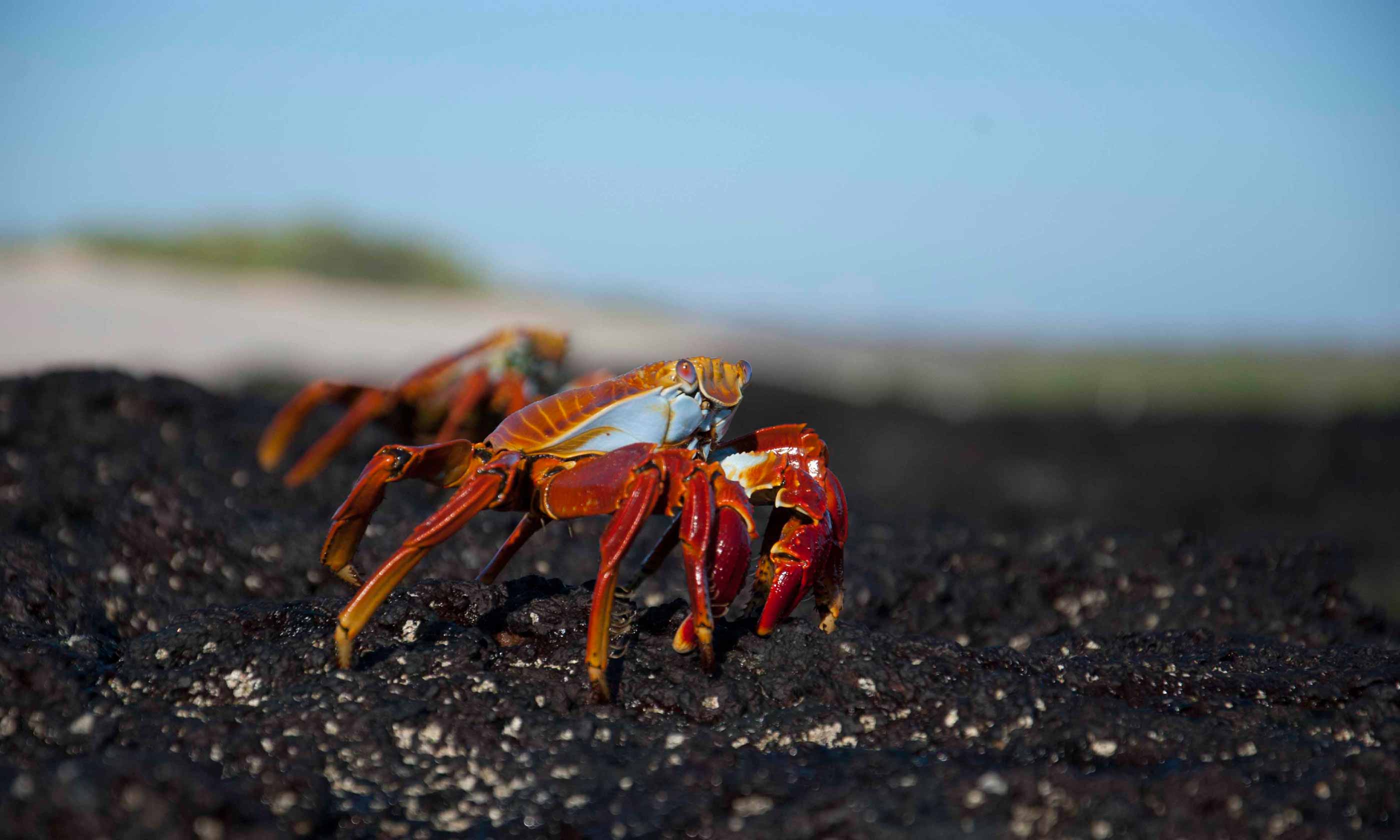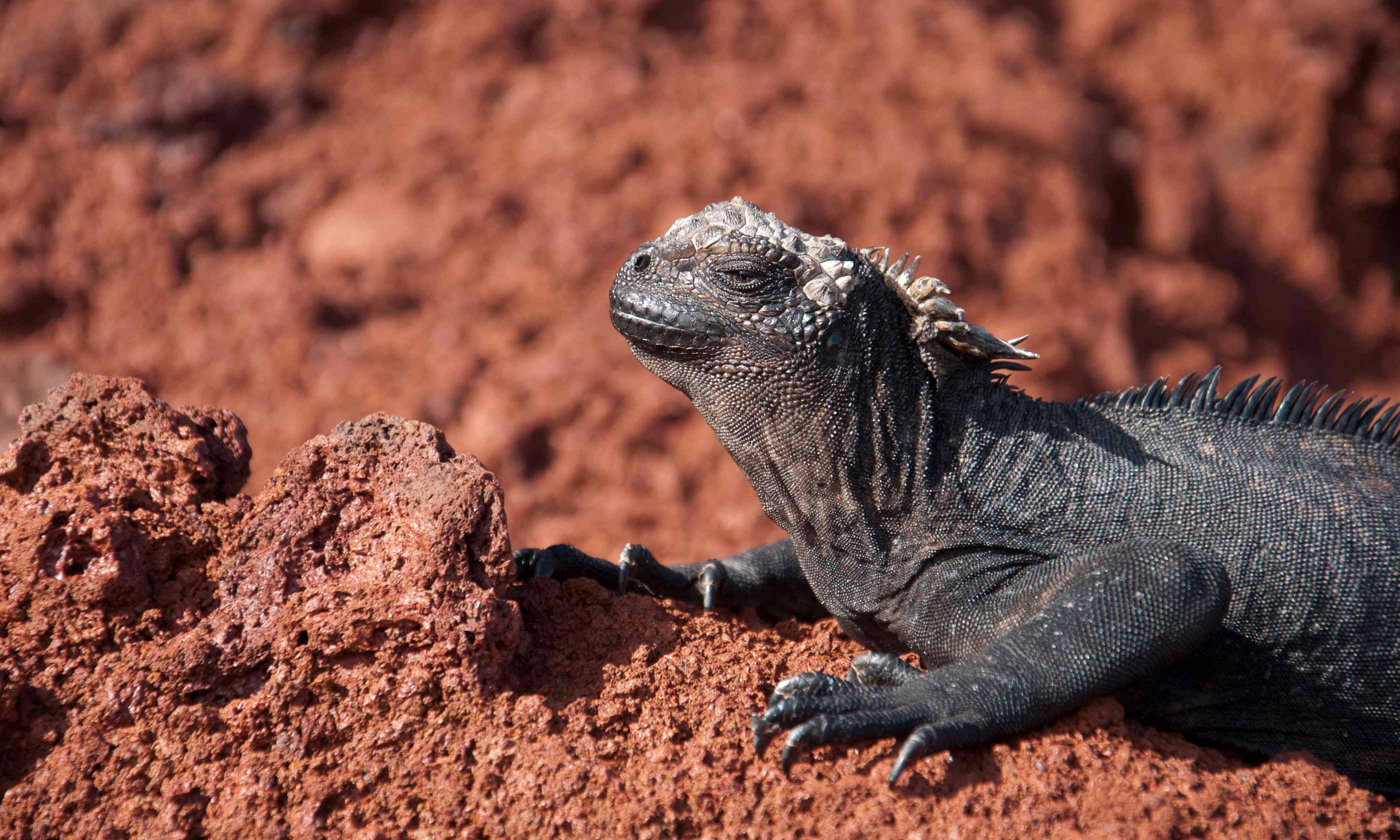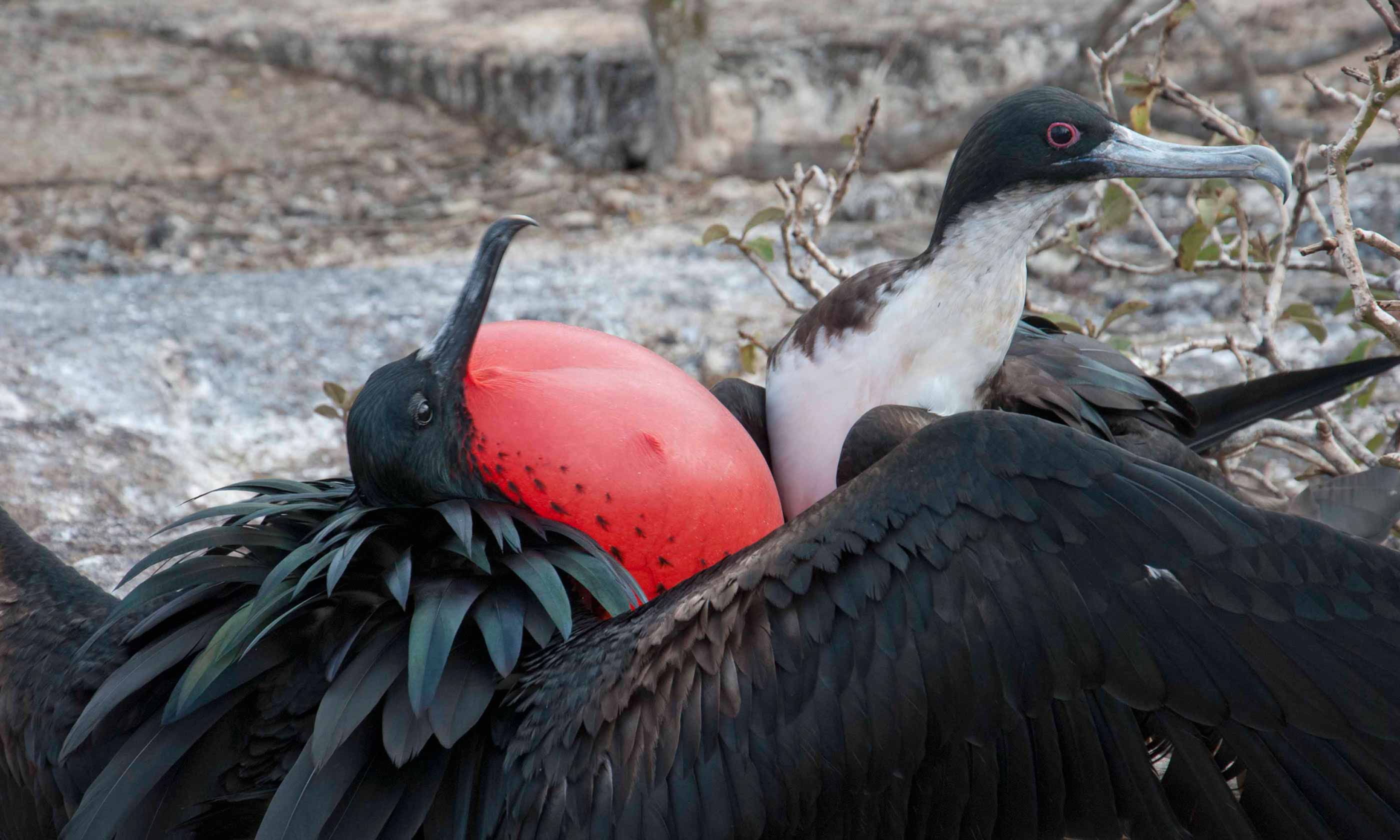
What better place than the Galápagos Islands for a Festival of Wildlife? Lyn Hughes joins the experts for a different take on this unique archipelago
It was a sizzling afternoon on North Seymour Island – in more ways than one. A female blue-footed booby sat on a rock, flanked by two males feverishly courting her. She glanced disdainfully from side to side as they vied for her attention, stretching their necks and heads to the sky and arching their backs in a yogic Salute to the Sun, and then dancing, slowly raising one blue foot, then the other.
Eventually she must have given a come-hither sign to one of them because it jumped on the rock and danced next to her, gradually encouraging her to join in. The other male continued to prance, but looked increasingly dejected as the courting pair gazed into each other’s eyes and enacted the booby equivalent of a passionate tango. “Come on baby – light my fire,” muttered someone next to me.
No matter how much you have travelled, you’ll be constantly surprised and bemused by the wildlife of the Galápagos. On this unique, remote archipelago in the Pacific, the animals have never learned fear of man. They ignore the cameras clicking just metres away from them and simply get on with their daily business.
Every island has a completely different atmosphere, different landscape and different species. One day you’re watching giant tortoises mate in swirling highland mists, the next you’re snorkelling with sharks in an aquamarine sea. And, as anyone who has heard of Darwin knows, neighbouring islands have sub-species that have evolved differently, whether in the shape of its shell, or its type of bill.
I’d been fortunate enough to visit the Galápagos in 1992 with my late husband, Paul Morrison. It was here that much of Wanderlust was schemed up, so it was a rather emotional return for me. It was a welcome surprise to find that our captain on this cruise, Eduardo Neira, was the very same captain Paul and I had met on that life-changing voyage 13 years ago. “I never get tired of the Islands,” Captain Neira explained to me, “I love the quiet and the space.”
Last year I joined the inaugural Festival of Wildlife, held in the Masai Mara, Kenya, and featured in Wanderlust’s Dec 04/Jan 05 issue. It was a huge success, and the same formula had been taken to the Galápagos.
The idea is to whisk a group of wildlife lovers somewhere special, but mix the usual activities with talks and workshops from a bunch of experts. Being in the Galápagos, we were joined by Darwin’s great-great-grandson and the BBC filmmaker who made the documentary Voyage of Darwin. The others included Big Cat Diary’s Jonathan Scott, Countryfile’s John Craven, wildlife artist Jonathan Truss, astronomer Professor John Parkinson, Wanderlust’s Mark Carwardine and various wildlife photographers.
The experts mixed freely with the passengers and were always on hand to dish out advice, adding an extra dimension to our activities:
“What’s interesting about a red-footed booby? Feet! So why did most people cut the feet off in their photos this morning?” photographer David Back asked us one day, laughing. “Please don’t make the same mistake with the blue-footed variety!”

Marine Iguana, Simon Chubb
“Try to get below the eye level of the subject,” David suggested as we pulled into the jetty. “Admittedly it’s a bit difficult with crabs!”
We were heading for the Charles Darwin Research Centre on Santa Cruz to get an introduction to the islands. Hundreds of bright orange Sally Lightfoot crabs were scuttling speedily over the rocks, while a couple of iguanas watched us inscrutably and a blue-footed booby did a spectacular divebomb into the water nearby. We were all reaching for our cameras before we’d left the boats.
Always on call, the experts were even issuing advice before breakfast. The following morning I woke before six and wandered up on deck to find a dozen other passengers already there and one of the photographers helping them to make best use of the dawn light.
Early lesson over, we split into groups for the shore landing. I joined the ‘Dolphins’ – people who wanted to learn to sketch. We disembarked onto Bartolomé, passing a couple of penguins as we pulled into the jetty.
We climbed up the 114m summit of the island and looked down to Pinnacle Rock and the sandy isthmus. The land was brown-black and craggy with scant vegetation and we were just discussing how much like the moon it looked when Professor Parkinson interjected excitedly: “Everyone says it’s a lunar landscape, but it’s nothing like that! It’s like Mars! Look for the lava tubes!”
However, by this point we’d been distracted by a hawk moth pretending to be a hummingbird, while our guide Rocio was gushing over a lava lizard eating the flowers of a tequila plant: “It’s unusual to see this behaviour – normally you just see them basking but not eating.” Rocio has worked as a naturalist guide for 19 years, but she’s still passionate about her job. “I love it,” she exclaimed, “there is something different all the time.”
On the way back down, we stopped at a spot overlooking a submerged volcanic crater; penguins, sea lions and a turtle were splashing and gliding in the water below. We pulled out our sketchbooks and Jonathan Truss talked us through the basics of successful art.
“The rule of thirds applies just as much to sketching as it does to photography. Go on – put something in there. Don’t be afraid!” he encouraged as we struggled with our pencils. “And if you’re painting later, note the aquamarine sea, the cobalt sky, the Mars-red of the rock. You’re looking at tonal values. There’s no black in nature.”
We were all rather tentative with our first attempt at sketching and it was with a mixture of relief and regret that we were told that time was up.
It was almost impossible to fit everything you wanted to do into a day. After lunch I was torn between a talk on sharks and continuing my art classes; eventually I dragged myself away from the lecture to rejoin the artists.
Our boat – the 46-berth Santa Cruz – was speeding across the waves, which presented some unique challenges to us budding artists. Jonathan chuckled as the island he’d been painting disappeared from view: “It’s not easy with a moving target.”
I decided to blame the swell for my rather pathetic seascape.
Wildlife everywhere
Swinging ourselves out of the panga (small boat) and into the water off James Island – a ‘wet’ landing – we found the black-sand beach awash with honking sea lions. We crossed the island to an inlet where a group of shy fur seals swooped and played in the water.
Fur seals – actually a type of sea lion – were almost hunted to extinction on the Galápagos. Numbers are recovering but, as they breed only once every two years, it’s a slow process.
Marine iguanas, on the other hand, were everywhere. I was reminded of a wonderful quote from the 19th-century Captain Byron, read out to us by Randal Keynes, Charles Darwin’s descendent: “We landed among an innumerable host of sea-iguanas, the ugliest living creatures we ever beheld. They sat on the black lava rocks like so many imps of darkness.”
It was hard to avoid stepping on these imps of darkness. The keener photographers lay in rockpools and sprawled across ground splattered with iguana excrement as they desperately tried to get below eye-level.
“I was lying on an iguana’s tail without realising. I moved and it wriggled away,” one of the group admitted rather guiltily, “but what an amazing experience to be surrounded by them – what a privilege.”
Zoologist Mark Carwardine has seen many of the world’s most extraordinary wildlife wonders but it was his first visit to the islands, and even he was stunned at how unperturbed the animals were by our presence. “You’d think there would be some instinct that would make them wary, that having something big loom over them could be dodgy,” he marvelled, “I can’t get over this.”
Professor Parkinson was also bursting with excitement, but it wasn’t the critters that had him so ecstatic. “Everywhere you look you can see evolution. Not just in the wildlife, but in the landscape too.”

Frigate birds, Simon Chubb
That evening he gave a talk that helped us put what we’d seen that day in context. He explained how the Humboldt Current circulates past Antarctica and up to the Galápagos, keeping the water cold and helping to explain the presence of penguins so far north. Then he took us up on deck (now dubbed the Stardeck) where he navigated us around the incredible star-filled night sky. It was so hard to leave that some of us slept out on the sun-loungers.
Landing on a brilliant-white coralline beach on Genovesa Island, huge black frigate birds whirled above us like pterodactyls. They are the pirates of the skies, thieving most of their food from other birds. We cheered on a gorgeous little tropic bird as it cleverly evaded a frigate’s aerial assault by dropping into a lagoon and hiding against the rocks. Down at eye level, dozens of frigates perched in the low bushes, the males inflating their neck pouches into huge red balloons in an attempt to attract a female.
“Get people in some of your shots,” advised Jonathan Scott. “It will give scale and show how close the animals are. The frigate birds are black, so focus on something next to them – on the greenery, perhaps.”
Some of the group sat down to sketch, flourishing their pencils with a lot more confidence than they had 24 hours earlier.
Others had taken to the water to swim and snorkel. I strolled along the beach and discovered a shallow pool, the size of a large hot tub, connected to the sea through a gap in the rocks. Three sea lions, one a baby, swam in from the ocean, seemingly unperturbed by my presence, and I sat down quietly in the waist-deep water as they played in the pool. A handful of snorkellers swam in from the sea and joined me, sitting in a circle. The water was as warm and still as a bath, and the curious sea lions weaved around and between us, brushing softly against our legs. It was one of the most magical experiences of my life.
“Darwin stuffed up!”
Our eyes widened in shock.
Back on ship, Randal Keynes was giving a talk about his great-great-grandfather – and had a stash of surprises for us.
We were all dimly aware of the story of Darwin’s finches and how the fact that birds from different islands had different beaks suggested the theory of evolution to him. But Randal now turned that on its head. He explained that Darwin collected only a few finch specimens and didn’t record which islands they came from. It was actually the differences in mockingbirds from three different islands that opened his eyes to the possibility of species adaptation.
This revelation was a bit of a blow for Christopher Ralling, who had made Voyage of Darwin – his documentary had emphasised the importance of finches in leading Darwin to his theory of evolution. “The BBC spent thousands!” he joked ruefully.
Every day, Christopher took us through his documentary, and Randal read from Darwin’s pocket book.
One of the joys of the trip was that everyone – even the experts – learned so much. “Well, I never knew that...” became the ship’s catchphrase.
Expert and non-expert alike had been deeply touched by the Galápagos Islands. While most of my fellow passengers were wildlife nuts, a few had been dragged along by keen partners – and even they had been converted. “It was far better than I expected,” confessed one sceptic. “I wasn’t particularly into wildlife, especially birds, before I came. But they didn’t fly away! Now I’m hooked.”
Jonathan Scott pointed out that we’d all been struck by the wildlife bug: “I looked around me this evening and realised that we’d all caught it. Today has reminded us all of what a wonderful world we live in.”
But it was Randal Keynes who best summed up how this trip had affected all of us: “I’ve felt humbled by this experience. There are no creatures anywhere on the planet that are like the animals of the Galápagos for putting us in our place."
When to go: The Galapagos is a year-round destination – the wildlife is always there. The rainy season is January to May, although it doesn’t necessarily rain every day (the author visited in April and had no rain at all) or for very long. This is the best time for snorkelling as the water is at its warmest. The dry season is June to December and is cooler with occasional fog. Christmas, Easter and June to August are the high season.
Getting there: The author travelled with Wildlife Worldwide, which organises the Festival of Wildlife.
Health & safety: The Galápagos Islands are on the equator, so take a hat and lots of sun-block (ideally waterproof, so it works when you’re snorkelling), and drink plenty of water. Take motion sickness tablets, sea bands and ginger tablets if you’re susceptible to seasickness.